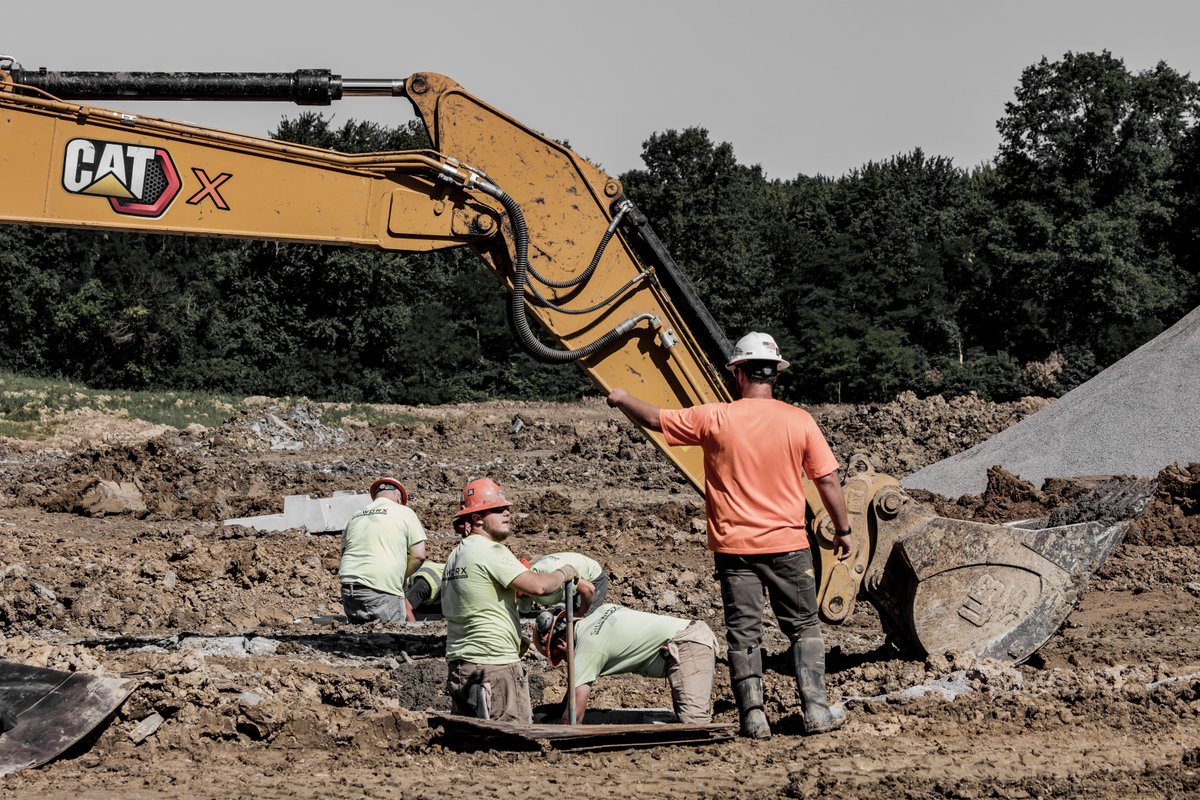Home>diy>Building & Construction>What Math Do Construction Workers Use


Building & Construction
What Math Do Construction Workers Use
Modified: August 27, 2024
Discover the math skills essential for construction workers. Learn how building-construction professionals apply mathematical concepts for accurate measurements and calculations.
(Many of the links in this article redirect to a specific reviewed product. Your purchase of these products through affiliate links helps to generate commission for Storables.com, at no extra cost. Learn more)
Introduction
Construction workers play a crucial role in building our cities, homes, and infrastructure. While many may think of construction as a physically demanding job, it also requires a strong foundation in mathematics. From basic arithmetic to advanced calculations, construction workers regularly utilize various mathematical concepts to ensure accuracy, efficiency, and safety on the job site.
Mathematics is the language of construction, and it is essential for workers to have a solid understanding of its principles. Whether it’s measuring materials, calculating angles, or estimating costs, construction workers rely on math to complete their tasks effectively. This article explores the specific areas of mathematics that construction workers use in their daily operations.
Let’s dive into the world of math in construction and discover the importance of each mathematical concept in the construction industry.
Key Takeaways:
- Mathematics is the backbone of construction, from basic arithmetic to advanced trigonometry and statistical analysis. It ensures accurate measurements, precise calculations, and informed decision-making, contributing to the stability and safety of constructed projects.
- Leveraging mathematical tools and software empowers construction professionals to enhance accuracy, reduce project risks, optimize resource utilization, and ensure the successful completion of construction projects. Incorporating mathematical concepts in software and digital solutions contributes to the efficiency, precision, and overall advancement of the construction industry.
Read more: What Equipment Do Construction Workers Use
Basic Arithmetic
Basic arithmetic lays the foundation for all mathematical operations in construction. Construction workers frequently encounter tasks that require addition, subtraction, multiplication, and division. These calculations are used in a variety of applications, such as measuring materials, determining quantities, and estimating costs.
For example, when ordering materials for a project, construction workers need to calculate the total quantity required. This involves adding up individual measurements and dimensions to determine the overall amount needed. Similarly, when estimating costs, workers use arithmetic to calculate the total expenses based on unit prices and quantities.
Accurate measurements are essential in construction, and basic arithmetic plays a crucial role in ensuring precision. Whether it’s measuring lengths, widths, or heights, construction workers use arithmetic to calculate dimensions and ensure that materials fit together seamlessly.
Furthermore, basic arithmetic is also utilized in time management on construction sites. Workers need to calculate project timelines, taking into account the number of workers available, the duration of each task, and the overall project deadline. This helps in allocating resources effectively and ensuring efficient progress.
Additionally, arithmetic is employed in calculating weights and loads. Construction workers need to determine the weight-bearing capacity of structures and ensure that they can safely support the intended loads. These calculations involve concepts such as weight distribution, load capacities of materials, and structural stability.
Overall, basic arithmetic serves as the building block for various mathematical operations in construction. It is essential for construction workers to be proficient in performing these calculations accurately and efficiently to ensure the success of their projects.
Measurement and Conversion
Measurement is a fundamental aspect of construction, and accurate measurements are crucial for ensuring that structures are built with precision. Construction workers use various units of measurement, and they often need to convert between different systems. Understanding measurement and conversion is essential for interpreting blueprints, calculating quantities, and determining spatial dimensions.
In construction, workers commonly use units such as inches, feet, yards, and meters to measure lengths, widths, and heights. They also use square units, such as square feet or square meters, to measure areas, and cubic units, such as cubic yards or cubic meters, to measure volumes.
Conversion between units is necessary when working with different measurement systems or when communicating with suppliers who use different units. Construction workers need to be proficient in converting measurements to ensure consistency and accuracy.
For example, if a blueprint specifies a length in inches, but the supplier provides materials in feet, construction workers need to convert the measurements to ensure that the materials are cut to the correct size. They may also need to convert between metric and imperial measurements depending on the project requirements.
Measurement conversions are also important when estimating quantities of materials. For instance, if the project requires a certain amount of concrete in cubic yards, but the supplier provides the pricing in cubic meters, construction workers need to convert the quantities to ensure accurate cost calculations.
Moreover, precise measurements are essential for ensuring that components fit together properly. Construction workers use measurement tools such as tape measures, levels, and laser devices to obtain accurate dimensions. These measurements are critical for aligning walls, leveling floors, and installing fixtures.
Understanding measurement and conversion enables construction workers to interpret plans and communicate effectively with suppliers and team members. It ensures that materials are ordered correctly, quantities are estimated accurately, and structures are built to the desired specifications.
Geometry
Geometry plays a significant role in construction, as it deals with the properties and relationships of shapes, angles, and distances. Construction workers regularly apply geometric principles to various tasks, such as laying out foundations, framing structures, and determining precise angles.
One of the key applications of geometry in construction is in the layout and design of structures. Construction workers utilize geometric concepts to accurately place and align foundation walls, columns, and beams. This involves understanding angles, parallel lines, perpendicular lines, and geometric shapes to ensure that the structure is stable and visually appealing.
Geometry is also used when working with architectural blueprints and detailed drawings. Construction workers analyze the dimensions, angles, and lines depicted in the plans to accurately construct the building. They use tools like protractors, plumb bobs, and theodolites to measure angles and ascertain the correct positioning of walls, roof slopes, and staircases.
Furthermore, geometry is crucial for calculating and determining accurate measurements. Construction workers use geometric formulas to calculate areas, volumes, and surface areas of various shapes. This information is vital when ordering materials and estimating quantities, ensuring that there is no wastage or shortage.
In addition, construction workers utilize trigonometry, a subfield of geometry, when dealing with triangles and angles. Trigonometric principles are applied when setting roof pitches, determining the rise and run of stairs, and calculating slopes and incline angles. These calculations are essential for maintaining structural integrity and safety.
Geometry also comes into play when working with complex architectural designs or creating decorative elements. Construction workers use geometric concepts to accurately cut and shape materials, ensuring a precise fit and seamless assembly. This attention to detail is crucial for achieving the desired aesthetics and functionality of the structure.
Overall, a solid understanding of geometry is essential for construction workers to ensure accurate measurements, precise alignments, and stable structures. By applying geometric principles, construction professionals can turn architectural designs into well-executed and visually appealing buildings.
Algebra
Algebra plays a significant role in construction, particularly in the areas of cost estimation, material calculations, and structural analysis. Construction workers use algebraic concepts to solve equations, manipulate variables, and make informed decisions in various aspects of their work.
One of the primary applications of algebra in construction is cost estimation. Construction projects involve numerous expenses, including materials, labor, equipment, and overhead costs. Algebraic equations are used to analyze these cost factors, compute total costs, and determine pricing for bids and proposals.
Construction workers also utilize algebra when calculating material quantities. By using formulas and equations, they can determine the amount of material needed for a specific project, taking into account factors such as dimensions, waste, and area coverage. This information is crucial for accurate material ordering and resource management.
Algebra is also used in structural analysis, particularly when determining load-bearing capacities and determining structural integrity. Engineers and construction professionals apply algebraic principles to establish equations that help assess the forces and stresses acting on a structure. This information is crucial for ensuring that buildings are safe and meet the necessary standards and regulations.
Additionally, algebra is used for calculating angles, slopes, and gradients. Construction workers need to determine the inclination of ramps, the pitch of roofs, and the angle of staircases, among other applications. These calculations rely on algebraic formulas to ensure proper installation and structural integrity.
Moreover, algebra is employed in quantity surveying, which involves detailed measurement and estimation of quantities for various construction activities. By using algebraic equations, professionals can accurately determine the amount of materials required for each activity, enabling efficient project planning and budgeting.
By utilizing algebra, construction workers have the ability to estimate costs, calculate material quantities, analyze structural integrity, and make informed decisions throughout the construction process. With algebraic principles, construction professionals can ensure the efficient and successful completion of projects.
Construction workers often use basic math skills such as addition, subtraction, multiplication, and division to calculate measurements, estimate materials, and create layouts. Understanding geometry and algebra can also be helpful for more complex projects.
Read more: What Do Construction Workers Wear
Trigonometry
Trigonometry is an essential branch of mathematics that finds wide applications in the field of construction. Construction workers rely on trigonometric principles to calculate and measure angles, distances, slopes, and heights. By utilizing trigonometry, construction professionals can ensure accurate and precise construction, as well as maintain structural stability and safety.
One of the primary applications of trigonometry in construction is in determining angles and slopes. Construction workers use trigonometric functions such as sine, cosine, and tangent to calculate angles necessary for setting roof pitches, determining the inclination of ramps, and establishing the slope of a grading surface. These calculations are crucial for ensuring proper drainage, safe access, and aesthetic appeal.
Trigonometry is also utilized in measuring heights and distances. Construction workers often need to determine the height of buildings or structures, and trigonometry allows them to calculate these measurements using angles and reference points. Trigonometric functions help them accurately measure heights, ensuring that the design specifications are met.
Additionally, trigonometry is crucial in structural analysis and design. Construction professionals use trigonometric principles to evaluate loads and forces acting on a structure. By considering angles and distances, they can calculate the forces exerted on beams, columns, and other structural elements. This information aids in determining the material strength required and confirming the structural integrity of a building.
Trigonometry also plays a significant role in surveying and layout tasks on construction sites. Construction workers use trigonometric functions to calculate precise distances between points, establish right angles for aligning structures, and determine the positions of various elements in relation to each other.
Furthermore, trigonometry assists in the calculation of oblique triangle dimensions. In construction projects involving irregular shapes, such as roofs with multiple slopes or intricate architectural features, trigonometry is used to calculate the lengths, angles, and areas of these non-perpendicular triangles.
In summary, trigonometry is an indispensable tool for construction professionals. By applying trigonometric principles, construction workers can accurately calculate angles, distances, slopes, and heights, allowing for precise measurements, structural stability, and efficient construction processes.
Calculations and Estimations
Calculations and estimations are integral to the construction industry, as they enable construction professionals to determine accurate measurements, budgets, and timelines. From estimating material quantities to calculating project costs and durations, construction workers rely on various mathematical calculations and estimations to ensure the successful completion of their projects.
One of the key aspects of calculations in construction is estimating material quantities. Construction workers use mathematical formulas and equations to determine the exact amount of materials required for a project. By considering dimensions, waste factors, and specific project requirements, estimations can be made for materials such as concrete, steel, lumber, and roofing materials. Accurate material calculations prevent unnecessary wastage and ensure sufficient availability for the project.
Construction professionals also employ calculations to estimate project costs. By factoring in labor costs, material prices, equipment rentals, subcontractor charges, and overhead expenses, construction workers can calculate the overall cost of a project. These calculations provide essential information for project budgeting, cost control, and decision-making.
In addition to cost estimates, calculations are crucial for estimating project durations. Construction workers analyze the scope of work, project requirements, and labor productivity rates to estimate the time needed for project completion. By considering dependencies between tasks and potential delays, project schedules can be developed, providing a roadmap for efficient project management.
Calculations and estimations are also used for determining productivity rates and performance benchmarks. By analyzing historical data, construction professionals can calculate productivity rates for various trades and activities. These calculations aid in staffing decisions, resource allocation, and performance tracking.
Furthermore, calculations play a vital role in safety planning and risk management. Construction workers use mathematical models and simulations to estimate potential risks associated with tasks and identify appropriate safety measures. By conducting calculations related to load capacities, structural stability, and safety factors, construction professionals ensure that the project is executed safely and in compliance with regulations.
Accurate calculations and estimations are crucial in construction as they enable informed decision-making, efficient resource management, and successful project execution. By utilizing mathematical calculations, construction professionals can ensure that projects are delivered on time, within budget, and up to the desired quality standards.
Statistical Analysis in Construction
Statistical analysis plays a significant role in the construction industry, enabling construction professionals to make data-driven decisions, evaluate project performance, and mitigate risks. By applying statistical techniques, construction workers can gather and analyze data to gain insights, identify trends, and improve project outcomes.
One of the key applications of statistical analysis in construction is in the field of quality control. Construction professionals collect data throughout the construction process to monitor and assess the quality of materials, workmanship, and finished structures. Statistical techniques, such as hypothesis testing and control charts, are used to analyze this data and identify any patterns or deviations from the expected quality standards.
Statistical analysis is also used in risk management. Construction projects are inherently complex and involve various uncertainties and risks. By conducting statistical analysis on historical data and project information, construction professionals can quantify risks, estimate their potential impact, and develop risk mitigation strategies. This helps in reducing the likelihood of cost overruns, schedule delays, and safety incidents.
Additionally, statistical analysis aids in performance evaluation and benchmarking. Construction workers use statistical techniques to compare actual project performance against established benchmarks, industry standards, or historical data. This analysis provides insights into areas of improvement, helps identify best practices, and supports decision-making for future projects.
Furthermore, statistical analysis is utilized in cost estimation and budget control. Construction professionals gather data on past projects, including costs, quantities, and durations, to develop statistical models for cost estimation. By analyzing this data, they can estimate project costs with better accuracy and manage budgets effectively. Statistical analysis is also employed to identify trends in cost overruns or cost-saving opportunities, enabling construction professionals to make informed decisions throughout the project lifecycle.
Moreover, statistical analysis supports resource allocation and optimization. Construction companies analyze historical and current data to determine labor requirements, equipment utilization rates, and material consumption patterns. By applying statistical techniques, they can optimize resource allocation, minimize waste, and enhance project efficiency.
In summary, statistical analysis in construction empowers professionals to make informed decisions, evaluate project performance, and manage risks effectively. By applying statistical methods, construction workers can improve quality control, enhance risk management, evaluate performance, and optimize resource allocation, ultimately leading to successful and efficient construction projects.
Mathematical Tools and Software in Construction
In the digital age, technological advancements have revolutionized the construction industry, offering various mathematical tools and software solutions to streamline processes and improve efficiency. These tools empower construction professionals to perform complex calculations, create detailed visualizations, and optimize project planning. Let’s explore some of the mathematical tools and software commonly used in the construction industry.
1. Building Information Modeling (BIM) Software: BIM software is a powerful tool that allows construction professionals to create digital representations of buildings and infrastructure projects. BIM software incorporates mathematical concepts and algorithms to generate 3D models, perform clash detection, simulate construction sequences, and analyze structural integrity. It enables collaboration among project stakeholders, enhances accuracy, and facilitates effective decision-making throughout the project lifecycle.
2. Cost Estimating Software: Construction projects involve intricate cost calculations. Cost estimating software utilizes mathematical algorithms to analyze project requirements, quantities, pricing data, and historical information to generate accurate cost estimates. These software solutions streamline the estimation process, minimize errors, and provide detailed breakdowns of labor, materials, and other project expenses.
3. Project Management Software: Project management software often includes mathematical features to facilitate scheduling, resource allocation, and budget management. These tools employ mathematical algorithms to optimize project timelines, allocate resources efficiently, and track project progress. They also provide forecasting capabilities, enabling construction professionals to make informed decisions based on mathematical models and data analysis.
4. Surveying and Measurement Tools: Construction relies heavily on accurate measurements, and various technological tools enhance precision and efficiency. Laser measurement devices, drones, and GPS technology utilize mathematical algorithms to capture precise measurements, calculate distances, and create accurate topographic maps. These tools assist in layout tasks, site analysis, and quality control.
5. Structural Analysis Software: Structural analysis software utilizes mathematical models and algorithms to assess the behavior of structures under different loads and conditions. These tools help engineers and construction professionals analyze the structural integrity, predict performance, analyze vibrations, and ensure compliance with building codes. They employ mathematical principles such as finite element analysis to provide detailed insights into the behavior of complex structures.
6. Estimation and Quantity Takeoff Tools: Estimation and quantity takeoff tools assist construction professionals in accurately calculating material quantities for various construction activities. These software solutions utilize mathematical algorithms to estimate the amount of material required based on project specifications, dimensions, waste factors, and other variables. They streamline the process, minimize errors, and enable efficient material ordering and resource management.
By leveraging these mathematical tools and software solutions, construction professionals can enhance accuracy, reduce project risks, optimize resource utilization, and ensure the successful completion of construction projects. Incorporating mathematical concepts in software and digital solutions contributes to the efficiency, precision, and overall advancement of the construction industry.
Read more: How Is Math Used In Construction
Conclusion
Mathematics plays a vital role in the construction industry, providing construction workers with the mathematical foundation necessary for accurate measurements, precise calculations, and informed decision-making. From basic arithmetic to advanced trigonometry and statistical analysis, construction professionals rely on various mathematical concepts and tools in their day-to-day operations.
Basic arithmetic serves as the building block for calculations in construction, enabling workers to estimate quantities, measure materials, and manage project timelines. Measurement and conversion skills ensure accurate dimensions and seamless assembly of structures.
Geometry and trigonometry are essential for the layout of structures, determining angles and slopes, and analyzing the forces acting on a building. These mathematical principles contribute to the stability and safety of constructed projects.
Algebra and statistical analysis support construction professionals in estimating costs, managing budgets, analyzing risks, and evaluating project performance. These mathematical disciplines enable data-driven decision-making and optimal resource allocation.
Mathematical tools and software, such as BIM software, cost estimating software, and structural analysis tools, enhance construction processes by applying mathematical algorithms to generate accurate models, perform complex calculations, and optimize project planning.
In conclusion, mathematics is an integral part of the construction industry. It empowers construction professionals to accurately measure and calculate, analyze data, solve complex problems, and optimize project outcomes. By incorporating mathematical principles and utilizing the available mathematical tools and software, construction workers can ensure precision, efficiency, and success in their projects.
With a solid foundation in mathematics and a commitment to leveraging the power of mathematical concepts and tools, construction professionals can continue to build and shape our world with accuracy, innovation, and excellence.
Frequently Asked Questions about What Math Do Construction Workers Use
Was this page helpful?
At Storables.com, we guarantee accurate and reliable information. Our content, validated by Expert Board Contributors, is crafted following stringent Editorial Policies. We're committed to providing you with well-researched, expert-backed insights for all your informational needs.














0 thoughts on “What Math Do Construction Workers Use”